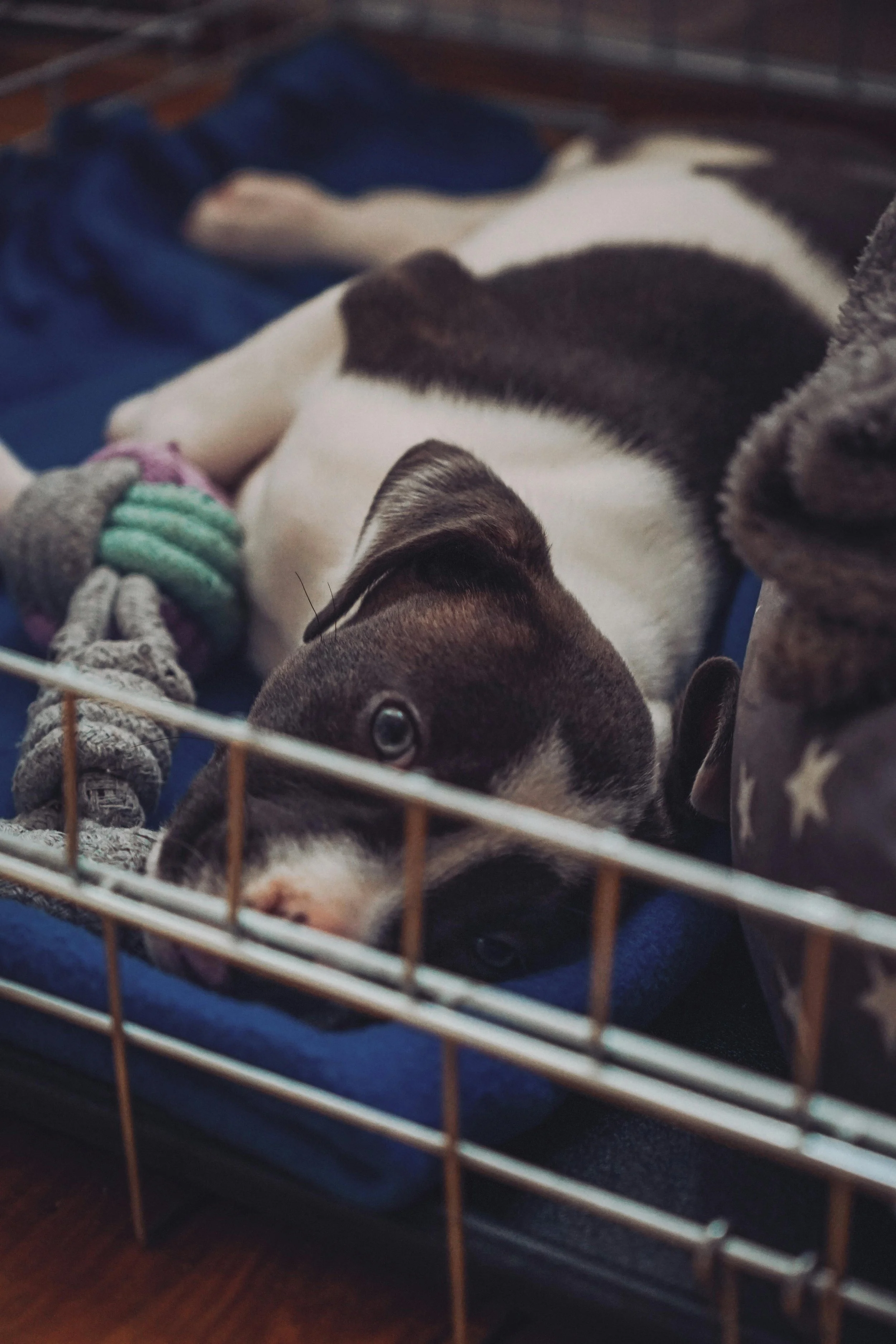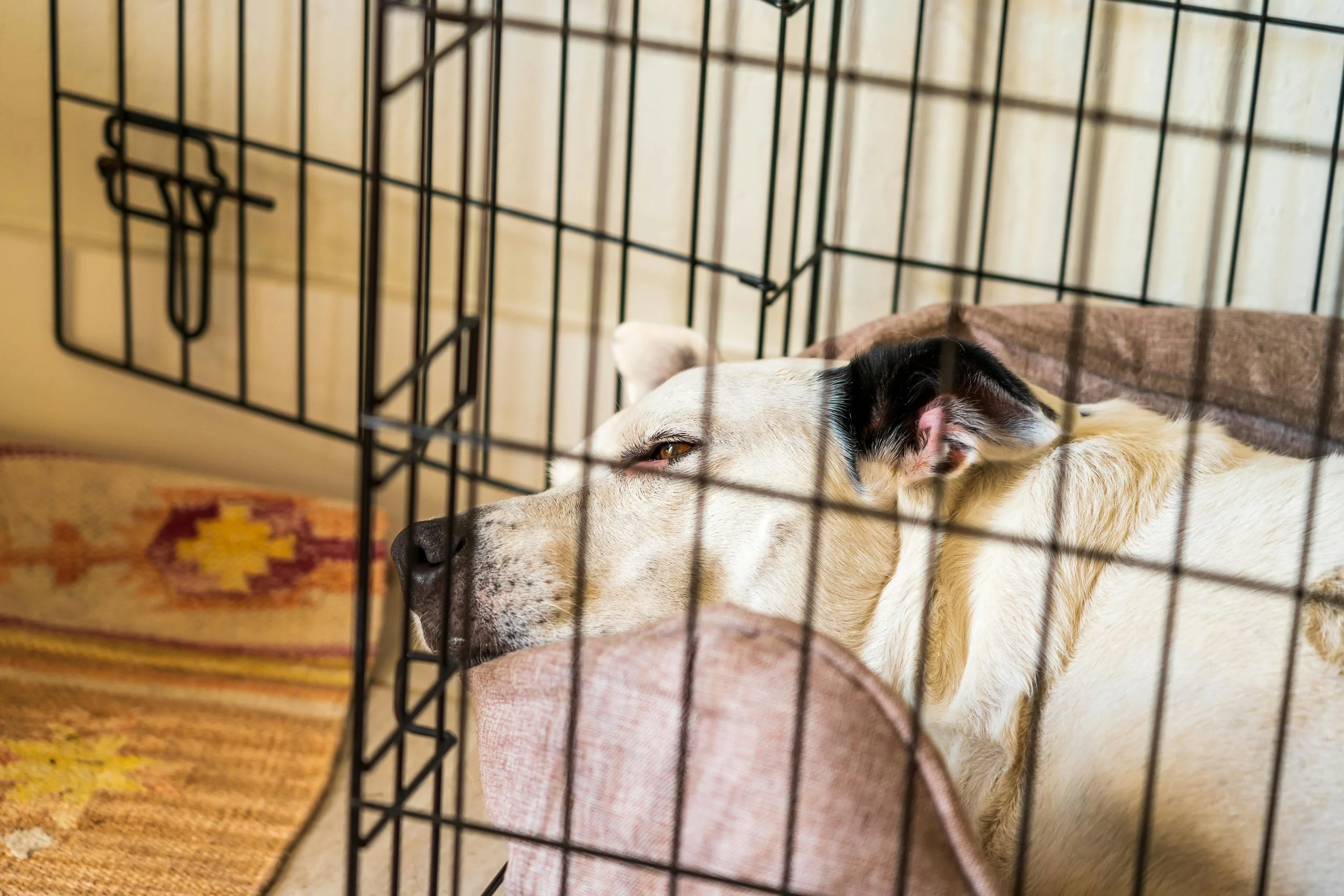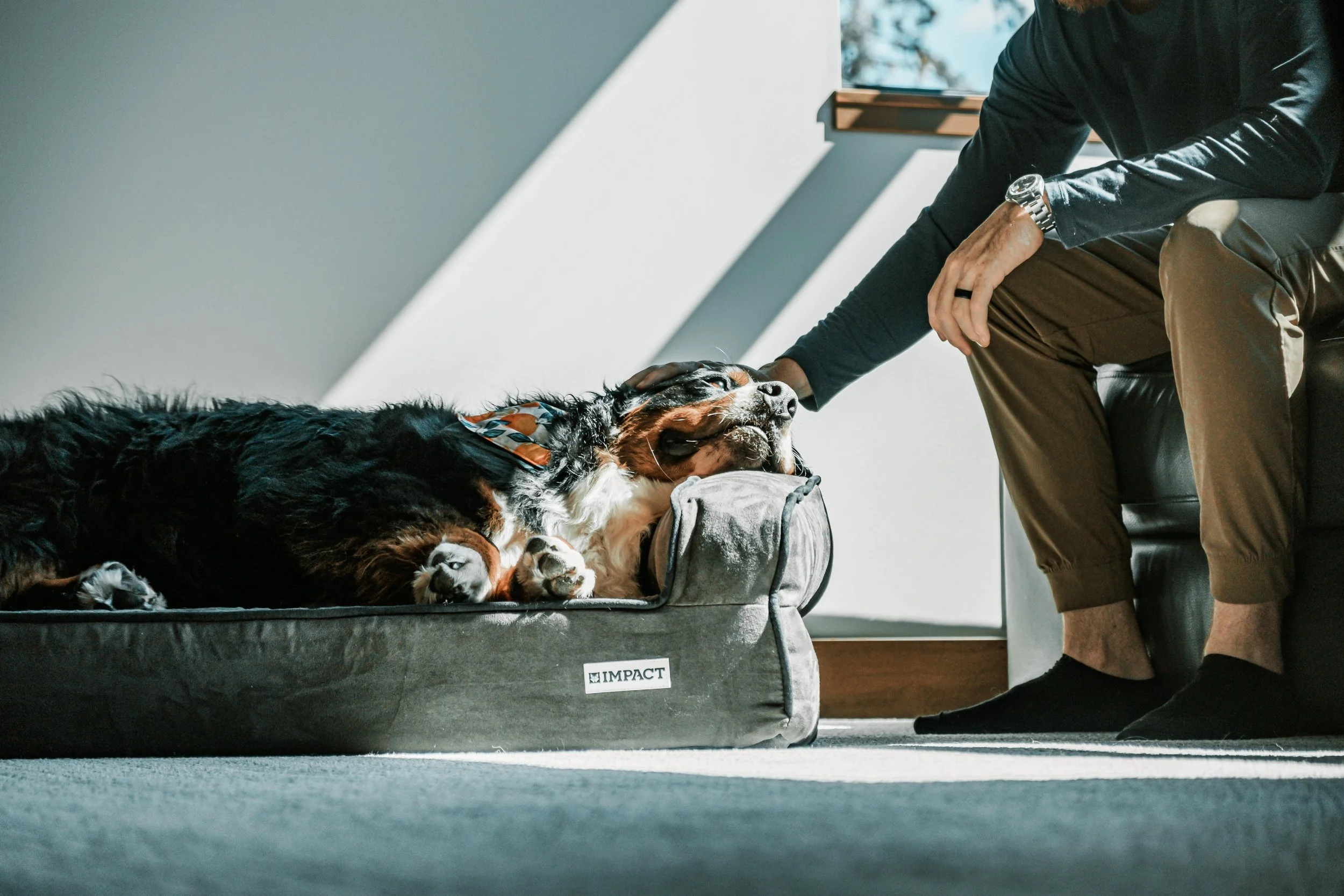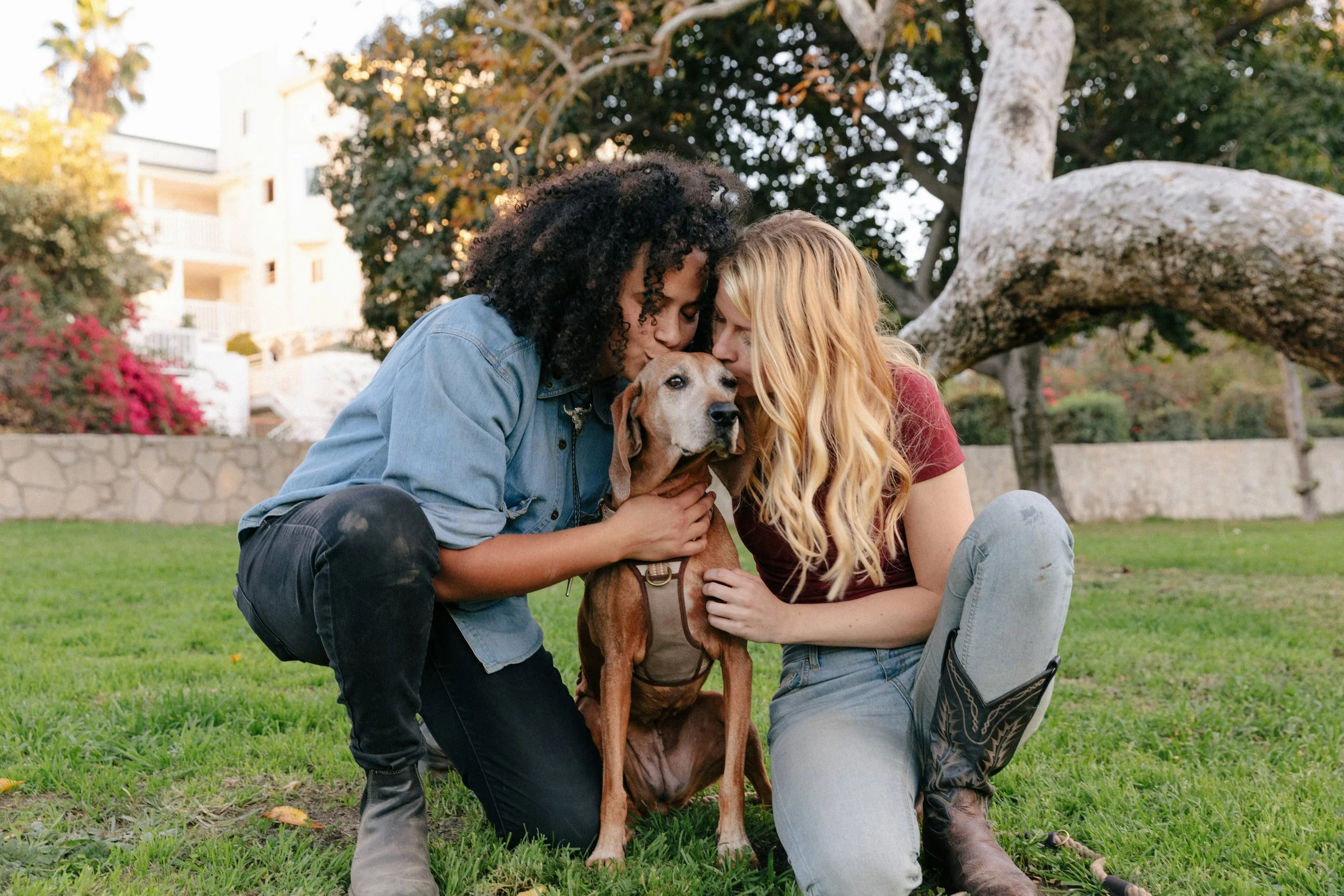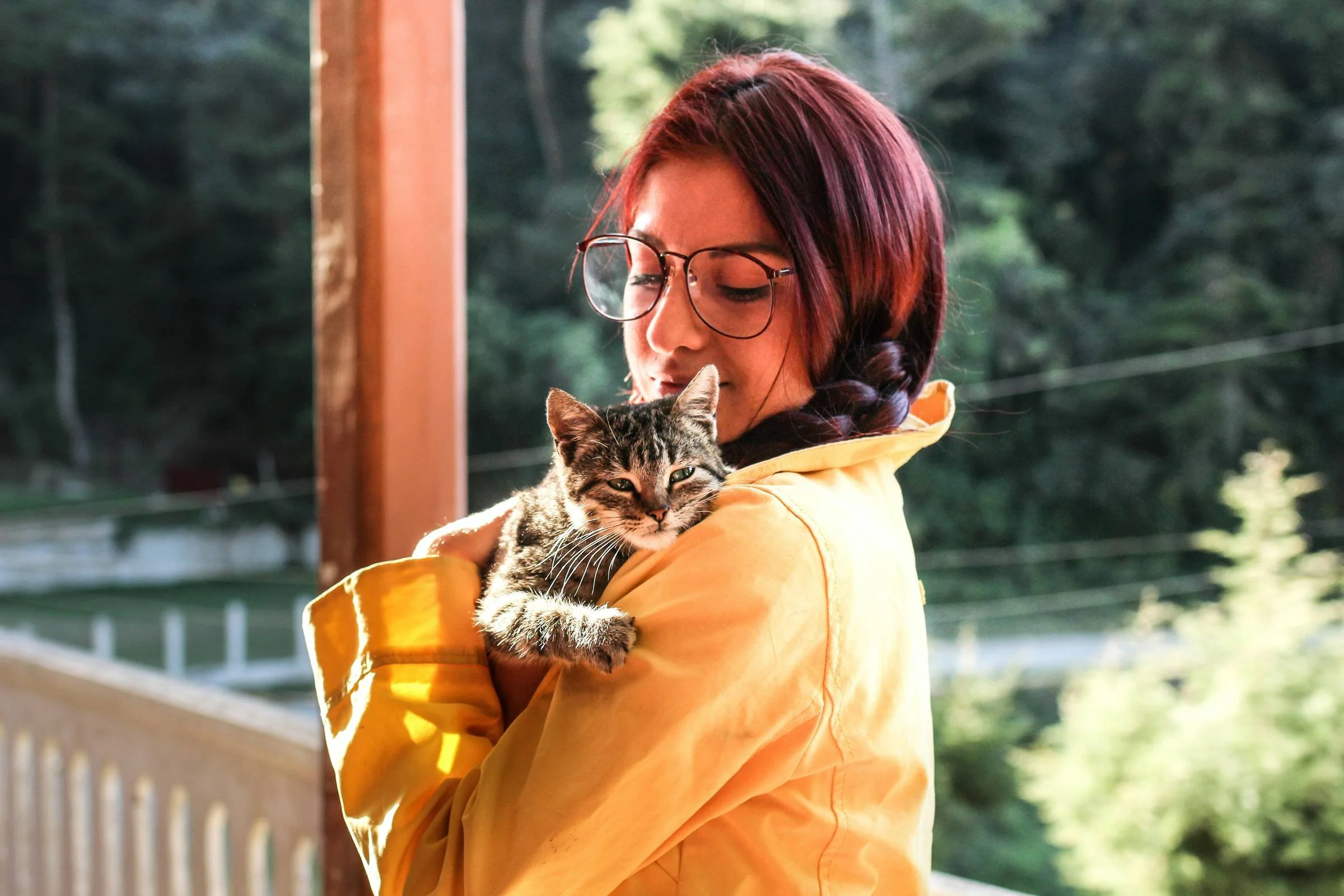🤔 Is This Truly A Safe Space For Dogs?
Ask any pet parent about what’s important to them, and they’ll likely mention something about keeping their pet safe.
But exactly how we view safety is where we might have differing opinions.
Take crate training, for example.
Some people might hear the word “crate” and envision a restraining box they would never put their dog in. Others might think of the safe space their dog loves retreating to throughout the day.
The more we talk to people about them (both pet parents and dog trainers), the more we realize a lot of people see the value in using them as an asset to help manage behaviors and strengthen their relationship with their dog.
And there’s even some science that backs why crates are instinctually a safe space!
Why the word “crate” might make us uneasy
Many of us love our pets so much, we think of them as our children. And there’s nothing wrong with that!
But an important perspective to consider is that no matter how we’d like to view them, they’re not the same as humans.
Brian Ferguson, dog trainer and owner of Agoge Canine in Hartsville, TN, has worked with 3,500+ dogs over the span of 24 years. He reminds us that dogs are simply hard-wired for things differently than we are.
Brian specializes in working with dogs who express behavioral concerns, so he focuses a lot on understanding how a dog’s brain operates on the chemical level and what role neurotransmitters play in how they behave.
“What causes a large majority of behavioral problems is when we over-humanize our animals.”
If someone we know has an aversion to crates, it’s worth taking a step back and understanding the perspective they’re viewing crates from. “They might be thinking, ‘I wouldn't want to be in a box. My dog doesn't want to be in a box.’”
Sian Lawley-Rudd, trauma-informed dog trainer of 6 years and owner of Lavender Garden Animal Services in Derby, England, shares a similar sentiment in that an aversion to crates could come from a couple of things: One, being a lack of education on how to use them positively, and two, a bad experience from one’s own past.
“Someone could have grown up with a dog who was put in a crate for punishment, and that was the only use it ever had. So they've grown up having that understanding that crates are punishment places, and they would never do anything like that to their dog, because it's horrible.”
Fortunately, these two experts agree: crates should never be used for punishment. And when presented in a positive and safe way, the crate actually becomes a space where dogs feel more comfortable and at ease.
Turns out, it’s a natural place for them to be.
How crates tap into dogs’ instincts
“Naturally, dogs are den animals. When they sleep, they turn off and are not able to protect or stay on guard and on watch. They want to be somewhere that is naturally isolated and safe.”
To Brian, part of what makes proper crate usage so successful is this link back to their ancestors. On top of that, “scientifically, dogs need 16 hours of sleep within every 24-hour period to prevent Central Nervous System deregulation.”
“Deregulation is what leads to all sorts of weird behavioral stuff: anxiety, depression, separation anxiety is a huge one, destructive behavior, aggressive tendencies, hyper protective resource guarding… a lot of that comes from CNS deregulation.”
Through his experience and education, Brian has uncovered that at times when we assume our dogs are bored and provide them with a bunch of toys and puzzles, they might actually just be lacking sleep. And since they can’t regulate themselves, they’re not going to choose to rest when they have all these things to keep them busy.
It’s a balance we need to find between providing them with mental stimulation but also allowing them that quiet time they’re hard wired for.
When they’re in their safe space (like a den or crate), they can allow themselves to completely relax and get that good-quality rest they need to function.
When crates become a safe space
When used correctly, a crate becomes a place dogs actually enjoy going to.
“It’s great for management for the human and great as a safe zone for the dog. Whether it's with visitors, or fireworks… whatever the situation. It benefits the dog because it becomes their little retreat, where they can feel like, ‘this is my place to go and no one's going to come and bother me.’”
Like many trainers, Sian helps pet parents establish the crate as a positive, safe place for their pets.
For her, that means associating the crate with a calm, relaxed body. As she’s helping pets establish that meaning, she’ll choose quieter activities where dogs are in a more relaxed state of mind.
“We want the dog to see this as a valuable place to go. It's about introducing rewards in there that ideally are going to be calming for them, so they start to build that association. It's not like a really exciting ‘oh, my God, play zone!,’ but rather a place that they can go and have a lovely, nice, long-lasting chew, or a lick mat, or a Kong… something that's going to help them genuinely relax in their bodies.”
Once that safe zone is established, it becomes a place of refuge. In addition to occasional stressful situations, many dogs will choose to go to the crate on their own when it’s time to sleep for the night.
Brian also notes how useful this space is in case of an emergency. From house fires to car accidents, crates can be the thing that saves a dog’s life.
“Having the crate skills on your dog is important from a safety standpoint. If a home catches fire while you're not there, your dog will go to the farthest point of the home and hide under the lowest object. The fire department will never find them.
If they're in a crate, then the location of the dog in the home can be noted, and even if the dog is stressed, the firefighters can pick up the crate and carry it out.”
But what if your dog isn’t calm enough for a crate?
Let’s be honest. Some of us have dogs that are just super nervous to the point that crate training might feel like an impossible task.
In cases such as separation anxiety or barrier frustration (we’ve all seen the dog who attacks the fence, right?), Sian notes there’s a larger issue that needs to be addressed before a crate can even be introduced.
“Say your dog has separation anxiety and you're trying to crate them. It might not be that they hate the crate. It might just be that they've got separation anxiety, and they really hate that separation. So we work on that first and then reintroduce the crate. And actually, they might like it.“
Another factor for dogs experiencing a lot of anxiety around the crate might be the physical crate itself. Brian has found this to be true in many of the dogs he’s worked with.
“One of the biggest things that causes crate anxiety is a crate that traps the dog, but also makes the dog feel exposed.”
Remember how we mentioned that dogs are naturally den animals? When they put themselves into a confined space, it needs to be something that also offers security from the “outside” world.
That’s why he feels wire crates tend to be problematic.
“In a wire crate, you can see right through it and they tend to be a little noisy and a little rickety–they're just not solid. And so the dog is in there, but we can't assume they would feel safe while also being exposed at the same time.”
And it makes sense. Think about how many times throwing a blanket over the crate seems to help the dog calm down. It’s for a reason!
“You’ve now taken away the visual element of being exposed. Now the dog is closed in and they feel much safer and more confined… That’s the reason it works. It lets the brain go, ‘okay cool, we’re good, we’re confined, we’re solid.’”
Creating a positive crate experience
Whether you’re approaching this for the first time or you’re ready to give it a go, a slow and steady approach will give the best results.
With puppies, Sian shares that there’s a common misconception around puppies being a “blank slate” and that they should be easy to train. Many puppies have been removed from their mom, their siblings, the humans they know, and their comfortable environment… all at once.
So when they go into their new home and start training, there’s a lot they’re working through! She finds they typically take a full week to become comfortable with a crate.
Adult dogs or rescue dogs who may have previous experiences or associations we don’t know of can also be successfully crate trained, it just might take a little more time and patience to help them feel calm in their bodies first.
This is where Brian sees the most resistance from pet parents. When they see their dog doesn’t want to go in, they give in to the dog’s behavior instead of being firm in training.
In a case where we know the dog doesn’t have a major catastrophic background of being in a crate, and we’re simply working through exposing them to something new, we have to follow through.
“If you start walking your dog towards the crate on a leash, and your dog starts backpedaling and pulling and spinning, what you absolutely cannot do is give into that pressure that the dog is creating.
In psychology, that’s called negative reinforcement. And if you relieve pressure when they’re doing that behavior, you’re actually reinforcing that behavior.”
It requires baby steps and patience, helping the dog see that nothing bad is happening with the crate.
Then, we can add value to the crate through food or desired items, and they start to change their feelings toward it.
Once it becomes part of the routine, the dog now has new boundaries and expectations around it. And ultimately, that helps them feel more connected to and trusting of you.
“It's a process, and it takes a lot of time and patience to let the dog work through their demons, and we can't force them to do it. We have to let them do it.”
To crate or not to crate?
In the end, it’s ultimately our decision as pet parents how we want our pets to live alongside us.
While there are many perks and benefits to crate training, and even some science that backs up why it works, it might not be the right fit for everyone.
And that’s okay!
In the end, we’re doing what we feel is best for our pets. And like humans, every pet is a unique individual with different needs.
If that means you’re already using a crate, or you’re curious and would like to try, it’s also an invitation to be kind to yourself as you work through the process. This is something Sian emphasizes with her approach, especially when things aren’t going as planned.
“There might be something else going on with the dog and we need to go into it a bit more deeply. It's not on you. If you've done all the right things with the dog and that crate, and they just don't like it yet, that's not on you. You’re doing your best.”
Whether you crate train or not, the boundaries you establish with your pets become a part of their everyday life.
But if you weren’t able to care for them anymore, would their new caregiver know what to do?
Whey would with a Cotl plan.
Putting a Cotl plan in place ensures your pet is taken care of, just the way they’re used to, no matter what happens to you.




